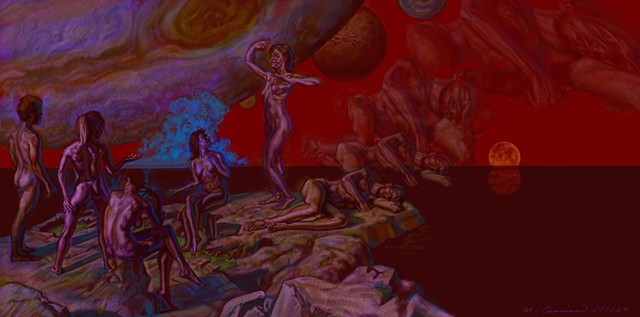Digital Paintings
* To enlarge, click over the image's upper right corner *
* For commentary about this painting, scroll down *
“Wine Dark Sea” continues my exploration of Ancient Greek spiritual beliefs about the cosmos, creation, and afterlife.
I’ve been reading a lot of Rudolph Steiner, and I’m very attracted to his ideas. Unlike Steiner, I’m not clairvoyant, and thus, have never had a spiritual experience that I can think of except for the desire for one. I have had many thoughts about my dad and about, oddly enough, a difficult friend who many years ago committed suicide at 48. My thoughts about my dead father I think anyone can understand, but thoughts still about a friend from whom I grew apart while he was still alive and who has been gone for many years? I cannot help but wonder if something else is going on! Him trying to communicate with me for some reason?
Thanks to his spiritual investigation and his clairvoyance, Steiner had many of his spiritual yearnings answered. However, he was brilliant enough to realize that answers often appear as questions. Framing an answer as a question encompasses more than the initial question asked in my opinion. At the very least, questions expand our awareness of what’s happening around us and of possibilities—including spiritual ones! A clear answer because of its clarity, leaves not much as much to contemplate as does a question as an answer. I think many would agree that questions as answers are by nature mysterious. I also think just as many would agree that mystery is attractive and is all the more beautiful because it cannot be fully known or answered. As a result, these questions as answers about spirituality, consciousness, and an afterlife are fine fodder for the form and content of my art.
I’m reading a book called “Growing Old: The Spiritual Dimensions of Ageing.” The author Frans Ackermann uses Steiner texts, his lectures, etc. about growing old in conjunction with his own (Ackermann’s) commentary. It’s excellent. One passage stood out, probably because I saw a lot of visual potential in it for this painting. This passage links the phases of human life with the planets. I’m sure every global root culture has such spiritual ideas, but Steiner uses the Ancient Greeks as his example.
The Ancient Greeks looked at the planets spiritually, claiming each planet-sphere has wisdom linked to it, which is also linked with and develops during a specific human phase of life. For instance, the planet Venus is linked with sexual development and the apotheosis of the spiritual becoming fully incarnate: puberty to age 21. My favorite ‘sphere’ is the moon, which contains wisdom about inspiration.
Steiner claims that after 21, humans move toward a spiritual development that moves away from physicality, materiality, and more toward a spiritual world that is linked to the cosmos—or at least the solar system! In other words, after the age of 21, corporeality wanes and spirituality waxes.
According to Steiner, a person can only understand the wisdom of a planet-sphere-life phase after one goes through it; thus, if one is in the Venus Phase, one cannot access the wisdom of this planet sphere and life phase until one is standing and looking back on it. This makes so much sense and definitely relates to the old saying that “hindsight is 20/20.”
I’m not sure why astronomers named the planets after Roman Gods. The Romans, from my understanding, believed in most of the same Gods as the Greeks. Why not use the older Greek names? For that matter, why not name the planets after various Gods from various cultures around the world and not just the West? Because I’m so interested in Ancient Greek religion right now, I think about the planet names as Greek: Aphrodite for Venus, Zeus for Jupiter, etc.
In “Wine Dark Sea”, we observe Gods—or are they mere mortals?! Gathered on the shore of the dried-blood sea, they and we look up into a psychedelic sanguine sky. Zeus fills one quarter of this painting and also presides over the landscape as an intense sky-blue storm cloud on the horizon. Ares is just to the right and partially behind Zeus. Hermes is below and partially behind Zeus. Aphrodite is cropped by the upper edge of the composition. While I don’t depict Helios per se, His presence is felt as the predominate light source of this composition. Selene, although smaller than the other spheres except for Hermes, shines brighter than them all. Ah! Inspiration! The protean force behind the impulse to create and creation!
